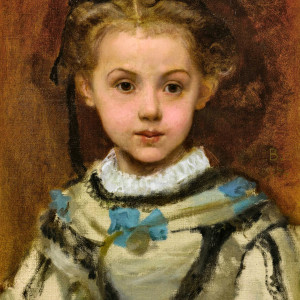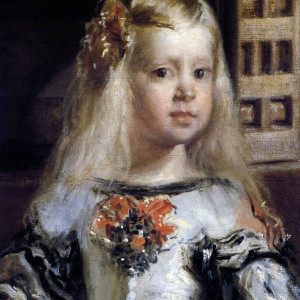
Detail of, Las Meninas, 1656, by Velazquez, showing Philip IV's daughter, the Infanta Margaret Theresa
47 by 35 cm.
"...that figure of a little girl called, I think, Guillemette, had the honor of reminding more than one critic of the witty, lively portraits of Velázquez.” - Charles Baudelaire
Provenance
Mme la baronne de Lareinty (acquired directly from the artist)Thence by descent (the sitter and until at least 1929)
Exhibited
Paris, Salon, 1859, no. 169 (as Guillemette)Paris, École Nationale des Beaux-Arts, Exposition au profit de l'Association des Artistes peintres, sculpteurs, etc., et du monument à élever à la mémoire de Paul Baudry, 1886, no. 27 (lent by la baronne de Lareinty)
Paris, Grand Palais, Paul Baudry au Salon des artistes français, 1929, no. 3432 (lent by the sitter)
Literature
Catalogue des œuvres de Paul Baudry: avec une étude par M. Eugène Guillaume, Paris, 1886, p. 30, no. 27Charles Ephrussi, Paul Baudry: sa vie et son œuvre, Paris, 1887, p. 176, 317
Marcel Fouquier, Profils et portraits: notes de littérature, Paris, 1891, p. 294
Paul Baudry, 1828-1886: les portraits et les nus, exh. cat., Historial de la Vendée, Les Lucs sur-Boulogne, October 26, 2007-February 3, 2008, p. 130
Catalogue note
The Salon of 1859 marked a pivotal moment in the evolution of modern French painting and a sharp break with tradition. It was the first Salon for Degas, Monet and Pissarro and also included the artists they counted as their inspiration, such as Delacaroix, Corot and Daubigny. 1859 showed history painting, long considered the acceptable Salon “subject machine,” slowly being replaced by genre and landscape.
Paul Baudry’s entries in 1859 provided a sampling of former successful Salon themes: religious scenes, mythological subjects and portraits. The Salon critics were harsh in their commentary on all but his portraits (Wolfgang Drost and Ulrike Henninges, ed., Théophile Gautier, Exposition de 1859, Heidelberg, 1992, p. 233-36), and his Portrait of Guillemette de Lareinty was praised by the critics for its “impressionistic” brushwork and charm.
Baudry’s portrait of this well-to-do young girl (she would later become Marquise of Paris), so uncharacteristic from his trademark Academic style, reveals that he was not immune to the shift that was occurring in the 1850’s, starting with the daring new brushwork of Courbet. But, perhaps of greater significance for this change in Baudry’s style was the influence that earlier Spanish masters were having on French painting at this time. In fact, in his review of the 1859 Salon, Charles Baudelaire singled out Baudry’s portrait: “Although his [Baudry’s] painting is not always sufficiently solid, M. Baudry is more naturally an artist. In his works one detects sound and loving Italian studies, and that figure of a little girl called, I think, Guillemette, had the honor of reminding more than one critic of the witty, lively portraits of Velázquez.” (Charles Baudelaire, Oeuvres completes, ed. by Claude Pichois, vol. II, Paris, 1975-76, p. 647).




